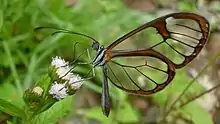| Pseudoscada erruca | |
|---|---|
 | |
| Scientific classification | |
| Domain: | Eukaryota |
| Kingdom: | Animalia |
| Phylum: | Arthropoda |
| Class: | Insecta |
| Order: | Lepidoptera |
| Family: | Nymphalidae |
| Genus: | Pseudoscada |
| Species: | P. erruca |
| Binomial name | |
| Pseudoscada erruca (Hewitson, 1855) | |
| Synonyms[1] | |
| |
Pseudoscada erruca is a South-American species of brush-footed butterfly in the Godyridina subtribe of Ithomiini.[2] It was described in 1855 by William Chapman Hewitson as Ithomia erruca.[1][3]
Distribution and habitat
The type locality of Pseudoscada erruca is Rio Grande do Sul in Brazil.[1][3] It also occurs in other parts of Brazil, such as Pernambuco,[4] and in Argentina.[1]
Pseudoscada erruca occurs in humid habitats with a permanent presence of water.[4] Research in 2009 on the frequency of occurrence of species in tribe Ithomiini in old-growth tropical forest versus nearby fragmented landscapes[lower-alpha 1] found that the presence of P. erruca was more frequent in the latter than the former.[5]
Behaviour
Females deposit individual eggs on the underside of leaves of Sessea brasiliensis and less commonly Cestrum spp., with a preference for plants at a height between 1 and 1.5 m in shaded spots.[2] Larvae feed from the leaves of the plant on which they hatch, generally developing better on S. brasiliensis than on Cestrum species.[2] Adults drink nectar, with a preference for the flowers of Rubus rosaefolius.[6] Adults of P. erruca are on wing in both dry and rainy seasons.[4]
Parasitoids
Pseudoscapa erruca is host to multiple species of parasitoid wasps, with at least one species each from genera Telenomus, Trichogramma, Diadegma and Mesochorus.[2] It has also been found parasitized by a tachinid fly species.[2]
Footnotes and references
Footnotes
References
- 1 2 3 4 Savela, Markku. "Pseudoscada". Lepidoptera and some other life forms. Retrieved 8 July 2018.
- 1 2 3 4 5 De Abreu, Verediana (2019). História natural e dinâmica populacional dos imaturos de Pseudoscada erruca (Nymphalidae: Ithomiini) e seus parasitoides em sua planta hospedeira Sessea brasiliensis (Solanaceae) [Natural history and population dynamics of immature stages of Pseudoscada erruca (Nymphalidae: Ithomiini) and their parasitoids on host plant Sessea brasiliensis (Solanaceae)] (PDF) (Master in Ecology) (in Portuguese). Instituto de Biologia da Universidade Estadual de Campinas. Retrieved 1 September 2022.
- 1 2 Beccaloni, G.; Scoble, M.; Kitching, I.; Simonsen, T.; Robinson, G.; Pitkin, B.; Hine, A.; Lyal, C., eds. (2003). "Pseudoscada erruca". The Global Lepidoptera Names Index. Natural History Museum. Retrieved 8 July 2018.
- 1 2 3 Nobre, Carlos Eduardo B.; Schlindwein, Clemens; Mielke, Olaf H. (16 April 2008). "The butterflies (Lepidoptera: Papilionoidea and Hesperioidea) of the Catimbau National Park, Pernambuco, Brazil". Zootaxa. 1751 (1): 35. doi:10.11646/zootaxa.1751.1.3. Retrieved 1 September 2022.
- 1 2 Uehara-Prado, Marcio; Freitas, André V.L. (February 2009). "The effect of rainforest fragmentation on species diversity and mimicry ring composition of ithomiine butterflies". Insect Conservation and Diversity. 2 (1): 24–25. doi:10.1111/j.1752-4598.2008.00025.x. S2CID 84850702. Retrieved 1 September 2022.
- ↑ Freitas, AVL (1996). "Population biology of Heterosais edessa(Nymphalidae) and its associated Atlantic forest Ithomiinae community". Journal of the Lepidopterists' Society. 50 (4): 279–284. Retrieved 1 September 2022.